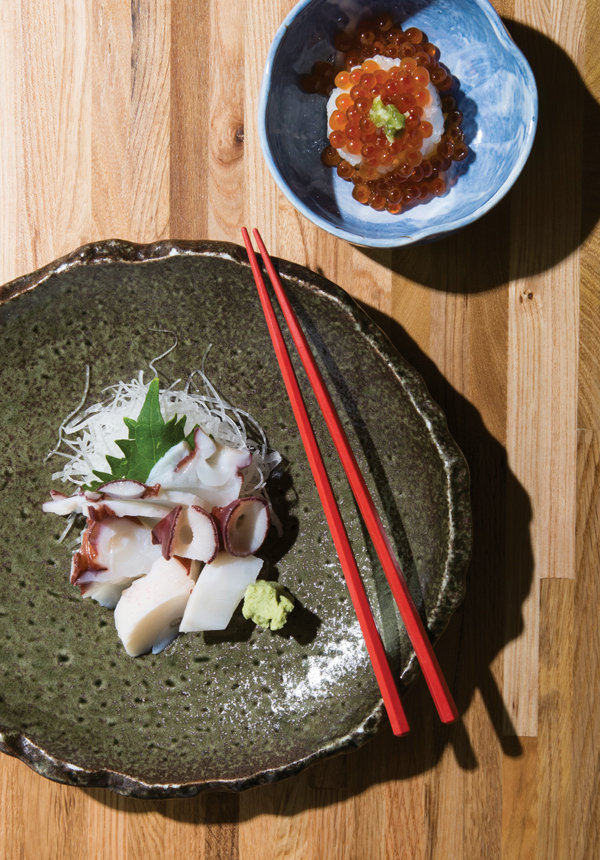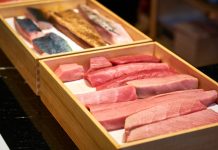
Photograph by Caroline C. Kilgore
Just try to get into Sushi Hayakawa. That’s not as much of a taunt as it sounds, but it’s definitely a challenge.

Photograph by Caroline C. Kilgore
I couldn’t do it at the end of last summer. I called every Monday, when the restaurant’s website said it started accepting reservations for the week, hoping for a callback and never getting one. Finally, the third week, someone actually answered the phone. It was the chef himself, Atsushi “Art” Hayakawa, who then embarked on a nearly 40-minute cri de coeur. Every night, he said, he had to turn down people like me who called or people who showed up at the door without reservations. He didn’t have the space to seat them. His staff didn’t have the capacity or time to serve more customers. Nor could he find any quality sushi chefs who could match the standards and technique he learned when he started training at the age of 15 in the city of Sapporo on his native island of Hokkaido. He made offers to chefs in New York City, but they kept falling through because nobody wanted to move here. He himself had offers to move to New York City, but no, Atlanta was his adopted city. Still, he wasn’t sure he could stand the pressure much longer. If I were serious about trying his sushi, I’d better get there soon. He was thinking of closing, maybe for a long break, maybe forever.
That break turned out to last five months. The event that precipitated it, he told me when he finally reopened, was when a woman sat down with her party, calmly took out a bag from McDonald’s, and started eating while her companions ordered off the menu. He closed the next week to reevaluate and to renovate in the same strip mall up Buford Highway. He resolved to build an atmosphere that would be sufficiently meditative that diners wouldn’t flinch at spending $100 a head. No crying babies—children under 12 would be banned, as would California rolls, rocket rolls, and those other fusion crowd-pleasers. In the new place, no one would think of yelling into a cellphone or, well, opening a McDonald’s bag.
He reopened in March with just five tables of four and a sushi bar that seats six, built from a slab of maple he spent months tracking down in remote sawmills and doing a fair amount of the construction himself. No need for another skilled sushi chef—he would be the sole artist, with a second chef preparing cooked dishes in an adjoining kitchen.

Photograph by Caroline C. Kilgore
So how hard is it to get in now? Plenty. The wait for a reservation averages three weeks, but at least now people actually answer the phone, usually starting at 3 p.m., and return messages. Thinking about walking in? Don’t bother. I watched as aspirants were turned away each evening I was there. Is all this worth the trouble? Yes. Hayakawa’s skill—his calling—is working with raw fish, much of it from his native Hokkaido. But be ready for a spare aesthetic. Sushi Hayakawa is not out to entertain you, like Craft Izakaya or MF Sushi. It has no rough or rowdy edges like most other sushi restaurants. Like the tea-green walls and framed pieces of black-and-white calligraphy, the feel is monochromatic. The spotlight is on the fish.
The revelations, too, are quiet, and found in the fish that diners often pass over in favor of surefire hits like bluefin and fatty tuna. Succulent amber-toned shima aji (striped jack) had a powerful near-tuna flavor I’d never noticed. Unless you’ve been to Cape Cod in the height of deep-sea scallop season, you won’t know how sweet and candy-like scallops can be. Hayakawa’s were so fresh and meaty, sliced for sashimi or for nigiri, that even at a second dinner we had to order more. His octopus proved that today’s de rigueur charring in cast iron and slathering with barbecue sauce is overkill, at least if the octopus comes from Hokkaido. He serves his raw, either as sashimi or carved into tiny cubes soaked with wasabi, and it’s more tender than most chefs realize is even possible.
Purists judge the skill of a sushi chef by the nigiri—slices of fish laid over seasoned rice—and, by extension, the rice. And Hayakawa is nothing if not a purist. Lavishly thick slices of fish—tuna, salmon, horse mackerel, red snapper—were curvily tucked beneath clouds of turnip threads. That thickness is particularly luxurious given the simple presentation: fish served over rice with a dot of wasabi. Nothing more. The house recommendation is a rarely seen premium wasabi of tiny jade-green shoots suspended in a clear soy brine. Be careful. It’s potent.

Photograph by Caroline C. Kilgore
Hayakawa is also an artist. A broad oval platter of sashimi came grouped around a whole fish frame curled with toothpicks as if just leaping out of the sea (the kitchen later sectioned it, deep-fried it, and brought it back to the table as a separate course). This artistry took time, and Hayakawa does everything, which explains why the platter took a full hour to arrive after we were seated. Fatty tuna, a super-rich and generally inert luxury elsewhere, was sheer opulence here: delicate but authoritative, providing a backbone for the foie gras–like texture of the light mauve strips. Uni (sea urchin) was lush, fresh, and sweet. Hayakawa will sometimes offer you the chance to compare uni from northern and eastern Hokkaido. Never say no.
The few rolls that bordered on the gimmicky, which Hayakawa had supposedly sworn off, were the weakest items on the menu: Panko-fried jumbo shrimp plunked indecorously tail-up in the middle of a cut roll were blown out with sesame mayo. Lobster salad draped with pink soy paper and cut into a rectangular “box roll” was pretty, like a ladies luncheon loaf, but the rice was cool and hard, the lobster undetectable under yet another mayonnaise cloak. Cooked food, too, is light on revelations, but I did want several dishes again—and soon. Japanese eggplant chunks were grilled and then pan-fried so that the flesh was as firm as custard. Impossibly tender, somehow fatless pork belly squares in a dashi broth were the most original and persuasive take on an overused cut I’ve ever tried. Sansai mozuku, a deceptively simple “mountain vegetables” cold appetizer, turned out to be a beaker of deep-brown, translucent liquid with nail-thin mushrooms. Made with several kinds of vinegar, the deeply fungal broth was cool and mysteriously refreshing, like something that would teleport you into a Japanese print of the mid-1800s.

It’s hard to imagine someone matching Hayakawa’s skill, or at least his sense of duty. His impassioned odes to his art and his adopted city demand local attention. We should go well out of our way to celebrate this sometimes tormented, driven artist. The question now is how much longer he’s willing to wait for the rest of Atlanta to figure that out.
Rating
★ ★ ★ ★
(Excellent)
Good to know
Reservations to dine and for omakase are required.
Vital Stats
5979 Buford Highway
770-986-0010
atlantasushibar.com
Correction: This story has been updated to reflect that the name Sushi House Hayakawa was retired in 2016 and replaced with Sushi Hayakawa.
This article originally appeared in our September 2016 issue.








![The North Carolina Museum of Natural Sciences’ newest exhibit is a [pre]historic first](https://cdn2.atlantamagazine.com/wp-content/uploads/sites/4/2024/04/DD-3-100x70.jpg)




